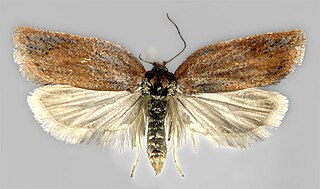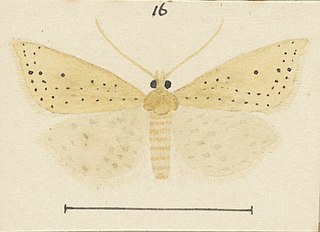Related Research Articles

Epinotia solandriana is a moth of the family Tortricidae. It is found in Europe, China, Korea, Japan, and Russia.

Archips rosana, the rose tortrix, is a moth of the family Tortricidae. It is found in both the Palearctic and Nearctic realms.

Epinotia signatana is a moth of the family Tortricidae. It is found from England and Scandinavia to the Mediterranean Sea, to eastern Russia, China, Korea, Burma and Japan.

Gypsonoma aceriana, the poplar shoot-borer, is a moth of the family Tortricidae. It is found from Europe to Russia, eastern Turkey and Iraq. It is also present in North Africa.

Rhopobota naevana, the holly tortrix moth, holly leaf tier or blackheaded fireworm, is a moth of the family Tortricidae. It is found from Europe to eastern Russia, China, Taiwan, Mongolia, Korea and Japan. It is also present in India, Sri Lanka and North America.

Acleris rufana is a moth of the family Tortricidae. It is found from northern, central and south-western Europe through southern Siberia to the Russian Far East and Japan.

Epinotia tetraquetrana, the square-barred bell, is a moth of the family Tortricidae. It is found from most of Europe east to the Near East and the eastern part of the Palearctic realm.

Cochylis dubitana, the little conch, is a moth of the family Tortricidae. It is found in China (Heilongjiang) and most of Europe. and the Caucasus. It is also found in North America, where it has been recorded from Colorado, Maine, Ontario and Washington.
Epinotia nigrovenata is a species of moth of the family Tortricidae. It is found in Chile.

Ancylis geminana, the festooned roller, is a moth of the family Tortricidae. It was described by Edward Donovan in 1806. It is found in most of Europe and has also been recorded from North America. The habitat consists of fens, marshes and damp heathland.

Cochylis pallidana, the sheep's-bit conch, is a moth of the family Tortricidae. It was described by Zeller in 1847.
Argyrotaenia griseina is a species of moth of the family Tortricidae. It is found in Peru.
Clepsis diversa is a species of moth of the family Tortricidae. It is found in Nuevo León, Mexico.
Epichorista crypsidora is a species of moth of the family Tortricidae. It is found in New Zealand.

Epichorista elephantina is a species of moth of the family Tortricidae. It is found in New Zealand.
Hedya zoyphium is a species of moth of the family Tortricidae. It is found in Colombia.

Eucosma cana, the hoary bell, is a species of moth of the family Tortricidae.
Zacorisca euthalama is a species of moth of the family Tortricidae. It is found on Seram Island of Indonesia.
Spatalistis orbigera is a species of moth of the family Tortricidae. It is found in India (Assam).
Recurvaria saxea is a moth of the family Gelechiidae. It is found in Brazil (Para).
References
- ↑ Baixeras, J.; Brown, J. W. & Gilligan, T. M. "Online World Catalogue of the Tortricidae". Tortricidae.com. Retrieved January 20, 2009.
- ↑ Exotic microlepidoptera, v. 1-5, Mar. 1912-Sept. 1936